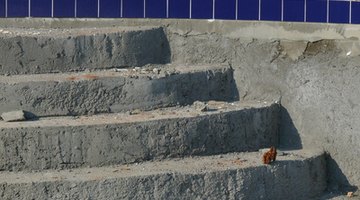Instructions for Concrete Block Pool Construction
Installing a pool in your backyard will make for some fun times and help to increase the resale value of your home. In-ground pool contractors tend to charge a lot of money for coordinating the many different subcontractors involved. You can save costs, however, by using a concrete block pool kit and using your own subcontractors. A small backyard pool of 12-by-24 feet with a 3-foot shallow end and a 6-foot deep end is good size for a small backyard.

Things You Will Need
- Excavating equipment
- Concrete
- Concrete blocks
- Rebar rods
- Pool pump and filter
- Plumbing lines
- Pool fixtures
- Electrical lines
- Level
- Hand tools
- Power tools
- Plaster or lining
- Stone coping
-
Determine the shape, depth, location and details of the pool design. Decide whether it will be finished with plaster and tile or a more durable custom vinyl pool liner. Obtain building permits from the local township. Stake out the perimeter, adding 12 inches to the desired size to allow for the width of the concrete block.
-
Cross-measure corner to corner to insure the rectangle is true. Hire a tractor operator to excavate, using a string level on the ground to verify the final perimeter is level. If the pool is to be 3-feet deep at the shallow end, dig an extra 6 inches for a poured concrete base and another 5 inches to factor in a flagstone coping and water line. Along the edge of the entire base, dig out a 16-inch wide by 8-inch deep footing.
-
Dig a hole for the main drain at the deep end with a trench through the wall to the pump and lay gravel in the channel after the pipes are installed. Install any necessary light boxes and wiring and make a 12-by-12-inch grid of #3 rebar at the base of the pool. Bend the bars upward along the sides of the base so the concrete block may be interlocked with it.
-
Have a truck pour concrete into the base as it is vibrated. Treat the surface with a rough-broom finish if you will be applying a plaster coating. When cured, after three days, begin laying the block wall to the level where the coping begins, 2 inches below grade. Cut out holes in the block for the return plumbing lines, light boxes and skimmers.
-
Make small, box forms for the skimmers and so the concrete will anchor them in place. Insert rebars into each of the block wall cavities. They should be long enough so that they stick up above the wall and fill each block opening with concrete as you shake the rebar and help the concrete to settle. Also pour a concrete collar around the pool walls to give them stability and add any stair details as necessary.
-
Fill in the outside of the pool walls with earth after the concrete has dried. Apply a plaster finish to the inside of the pool or a vinyl liner. Then set a flagstone coping along the top of the wall, using either cement or a more durable synthetic adhesive.

Tip
Install a hydrostatic relief valve at the bottom of the deep end to keep pressure from building underneath the pool, especially if the area is prone to some flooding.
Warning
As a precaution, attach copper wire to the rebar with brass ground clamps as an electrical ground in three locations and run it up out of the pool to ground level.
References
Writer Bio
Rick Warden writes on a wide variety of subjects. He has served as a freelance English editor and writer at "Eurasian Chemical Market Magazine," and his articles are featured at Faithful News and Revelife, among other online publications. Warden graduated from the Cooper Union School of Architecture, earning a Bachelor of Architecture degree.
Photo Credits
- Man with clothes on in swimming pool. image by Saskia Massink from Fotolia.com
- Man with clothes on in swimming pool. image by Saskia Massink from Fotolia.com
- step at pool image by jimcox40 from Fotolia.com
More Articles



